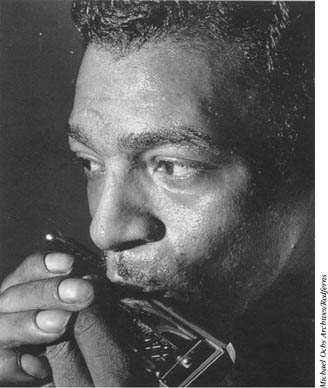
Some of the most idiosyncratic and memorable blues sounds were produced from the lips of Little Walter.
Many people consider Little Walter the world’s greatest blues harmonica player. In the words of author Robert Palmer, “almost everyone who picks up a harmonica … will at some stage in his development emulate either Little Walter or a Little Walter imitator.”
Little Walter was born Marion Walter Jacobs on May 1, 1930, near Marksville, Louisiana. He began playing the harmonica at age 8, and ran away from home to become a musician at age 12. By 1944 he was living in Arkansas, where he learned from harmonica player Sonny Boy WILLIAMSON and met Jimmie RODGERS. He incorporated jump blues style of saxophonist Louis Jordan into his playing after listening to his records.
Jacobs moved to Chicago in 1947 and became reacquainted with Rodgers, then came to the attention of Big Bill BROONZY. Soon Jacobs was working as a sideman accompanying Broonzy and other Chicago blues stars, including TAMPA RED and MEMPHIS SLIM. Jacobs began playing with the Chicago musician Muddy WATERS in the mid-1940s. By the end of 1948 he was a member of Waters’ band, and recording for Chess Records. Jacobs’ heavily amplified, evocative wail perfectly enhanced Waters’ powerful singing and whining slide guitar. He brought a new approach to an old-time instrument, combining jazz-influenced phrasing with solid musicianship. In his hands the harmonica was not just a supporting instrument, it was the musical focus. He skillfully used amplification, “playing” his microphone like an accompanying instrument.
Among Waters’ early hits featuring Jacobs were “Louisiana Blues,” the song that brought Waters national attention; “Long Distance Call”; “She Moves Me”; and “Honey Bee.” In 1952 the band recorded a harmonica-led tune titled “Juke.” It reached No. 1 in the rhythm-and-blues (R&B) chart and stayed in the Top 10 for 16 weeks. Little Walter left to lead his own group but still recorded with Waters on classics such as “Hoochie Coochie Man” and “I Just Want to Make Love to You.” Jacobs had eight Top 10 R&B hits. In 1954 he had a record on the R&B charts every week, and “My Babe,” reached No. 1 in 1955. Other hits included “Boogie,” “Boom Boom (Out Go the Lights),” and “Mellow Down Easy.” He recorded instrumentals and songs featuring his lead vocals as well as harmonica work for Chess Records in the 1960s. He performed in Europe in 1962, and toured with the ROLLING STONES in 1964. He died on February 15, 1968, in Chicago, from a heart attack after a street fight.

Some of the most idiosyncratic and memorable blues sounds were produced from the lips of Little Walter.
Stan Hieronymus
FURTHER READING
Cohn, Lawrence. Nothing but the Blues: The Music and the Musicians (New York: Abbeville Press, 1993);
Davis, Francis. The History of the Blues. (New York: Hyperion, 1995).
SUGGESTED LISTENING
The Best of Little Walter, The Best of Little Walter, Vol. 2; Confessin’ the Blues; Hate to See You Go.